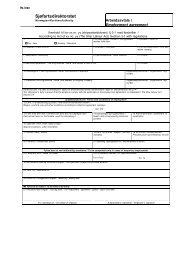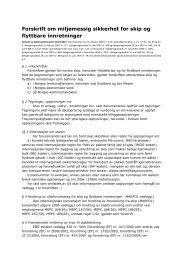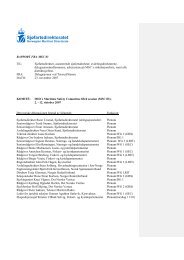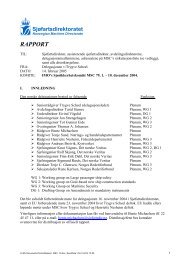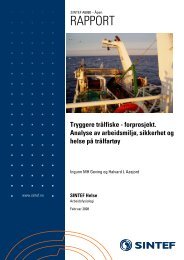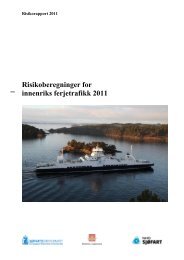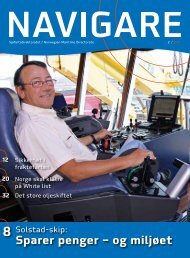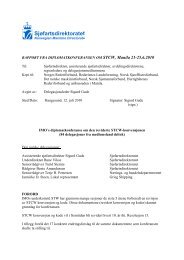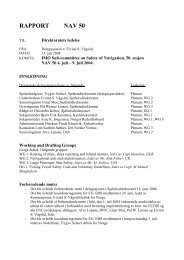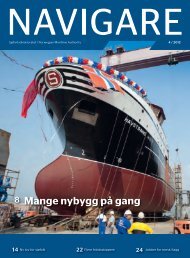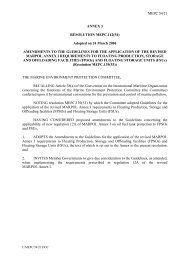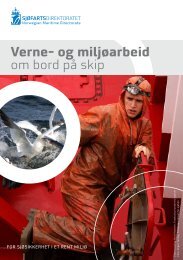You also want an ePaper? Increase the reach of your titles
YUMPU automatically turns print PDFs into web optimized ePapers that Google loves.
Collisions<br />
What happened?<br />
A pleasure craft (8 meters) whilst anchored 28 miles from<br />
the nearest land for the night in a shipping lane off the<br />
North East coast of Australia, with all hands on board<br />
sleeping, was struck by a passing bulk carrier. Fortunately<br />
there were no casualties. Th e collision went unnoticed by<br />
the OOW and the lookout on the bulk carrier.<br />
Why did it happen?<br />
Available evidence indicates that proper radar and visual lookout<br />
was maintained on the bulk carrier. Th ere could be several<br />
possible reasons for the pleasure craft not being observed on<br />
the bulk carrier: (i) pleasure craft presented a poor radar target;<br />
(ii) anchor light on the pleasure craft was too weak and<br />
did not comply with COLREGs; and (iii) refl ection of moonlight<br />
from the water prevented the pleasure craft hull being<br />
seen from the bulk carrier bridge. Another contributory cause<br />
to the collision was the lack of a lookout on the pleasure craft<br />
which was anchored in a shipping lane at night.<br />
What happened?<br />
Sudden steering system failure of an oil tanker led to collision<br />
with a passing bulk carrier in the Baltic Sea. Th e collision resulted<br />
in serious damage to both vessels and spillage of 2,700<br />
tonnes of fuel oil from the tanker.<br />
Why did it happen?<br />
Th e cause of the sudden steering failure could not be established.<br />
Small passing distance (0.5 miles) between the two<br />
vessels precluded eff ective avoidance action being taken on<br />
both vessels. Both vessels unnecessarily restricted their<br />
What happened?<br />
A passenger cruise ship collided with a container ship in a crossing<br />
situation in the Dover Straits. Both ships sustained serious<br />
damage including a very serious fi re on the container ship.<br />
Why did it happen?<br />
Th e attention of the passenger ship’s OOW was diverted by other<br />
tasks in a heavy traffi c situation. Th e container ship reduced its<br />
HOLD UTKIKK! I tett trafi kk er det ekstremt viktig<br />
å holde et godt øye med situasjonen.<br />
LOOK OUT! In heavy traffi c situations it is extremely<br />
important to keep good watch.<br />
FOTO: BENTE AMANDUSSEN<br />
What can we learn?<br />
Numerous collisions occur between large ships and small<br />
craft every year resulting from lack of proper lookout on<br />
one or both vessels. All watchkeepers need to be aware that<br />
small craft may not be readily sighted by radar or visually<br />
from the navigating bridge of large ships. Th e importance<br />
of proper lookout on all vessels, large and small, cannot be<br />
overemphasized and watchkeepers shall also be guided by<br />
Rule 5 on Look-out of the COLREGs. Smaller ships<br />
should consider warning larger ships of any developing<br />
collision risk by using all available means including light<br />
signals, sound signals and radio communication. Larger<br />
ships must remember that provision of proper radar lookout<br />
does not obviate the need for eff ective visual lookout<br />
and vessels with operational radar shall be guided by Rule<br />
6 (b) of the COLREGs. All ships including small craft,<br />
shall avoid anchoring in a known shipping lane.<br />
passing distanc e by choosing the deepwater route although<br />
their relatively shallow draft permitted them to use the recommended<br />
directions of traffi c fl ow outside the deepwater route.<br />
What can we learn?<br />
Vessels should avoid using deepwater routes when their draft<br />
permits them to use a traffi c separation scheme. OOW should<br />
remain at heightened alert when passing another vessel at close<br />
range and should be vigilant for equipment failure and unexpected<br />
response from own or other vessel including interaction<br />
between vessels passing each other at close distances.<br />
available options for avoiding action by overtaking another vessel<br />
from the port side just when a close quarters situation was developing<br />
with the passenger ship. Th e collision could have been<br />
averted if one or both vessels had reduced speed in good time.<br />
What can we learn?<br />
In heavy traffi c situations, doubling of the watch should be considered<br />
if there is a possibility of the OOW being distracted by other<br />
tasks such as need for radio communication for reporting ship’s<br />
position. Vessels shall follow Rule 13 of the COLREGs when<br />
overtaking any other vessel. In addition, when overtaking another<br />
vessel, careful consideration should be given to the side on which to<br />
overtake. Factors to be taken into account should include available<br />
sea room and possible need to take avoiding action in respect of<br />
other vessels in the vicinity. Th e OOW should not hesitate in reducing<br />
speed to avert collision if circumstances so require and<br />
should also be guided by Rule 8 (e) of the COLREGs.<br />
NAVIGARE 4 - 2007 63<br />
Lessons learned



